

Ave!
Attributed Trilobites
As seen in the photo, each of these trilobites comes with a complete attribution and are all c. 30mm
These are perfect for collectors and teachers on a budget!
For more information concerning trilobites, see below.
- Trilobites are extinct arthropods… distant relatives of modern lobsters, horseshoe crabs and spiders.
- Trilobites existed for approximately 300 million years.
- They lived from the Lower Cambrian Period (521 million years ago) to the end of the Permian (240 million years ago.)
- Their emergence and extinction bookend the Paleozoic Age.
- Trilobites are named not for their head (cephalon), thorax and pygidium, but rather for the three axial lobes that divide their body length-wise. (Did you know that?)
- Their fossilized remains have been found on every continent on earth.
- Trilobites ranged in size from 1cm to over 70 cm.
- There are over 20,000 scientifically recognized trilobite species.
- There are 10 “Orders” of trilobites, under which the more than 20,000 recognized species are organized.
- The earliest trilobites were of the order Redlichia… the most recent were of the order Proedita.
- In life, trilobites were covered by a thick chitinous exoskeleton which was molted as they grew.
- Many trilobite fossils represent remnants of their shed exoskeletons, rather than of the trilobites themselves.
- Some trilobite species have been found with long spines projecting from their shell… believed to have served as protection from predators.
- Trilobites were probably the first life forms with complex eyes, with some species having hundreds of individual lenses per eye.
- Some trilobites could enroll for protection.
- Some trilobite fossils show evidence of soft appendages used for feeding and locomotion.
- Famous “soft-bodied” trilobite localities include The Burgess Shale in British Columbia, The Emu Bay Shale in South Australia and The Chengjaing Formation in China.
- It is believed that while trilobites lived mostly in off-shore marine environments, some may also have existed in fresh water.
- Some trilobite fossils show signs of predation.
- Collecting trilobites has a long history… some have been found in human burial mounds dating back more than 50,000 years.